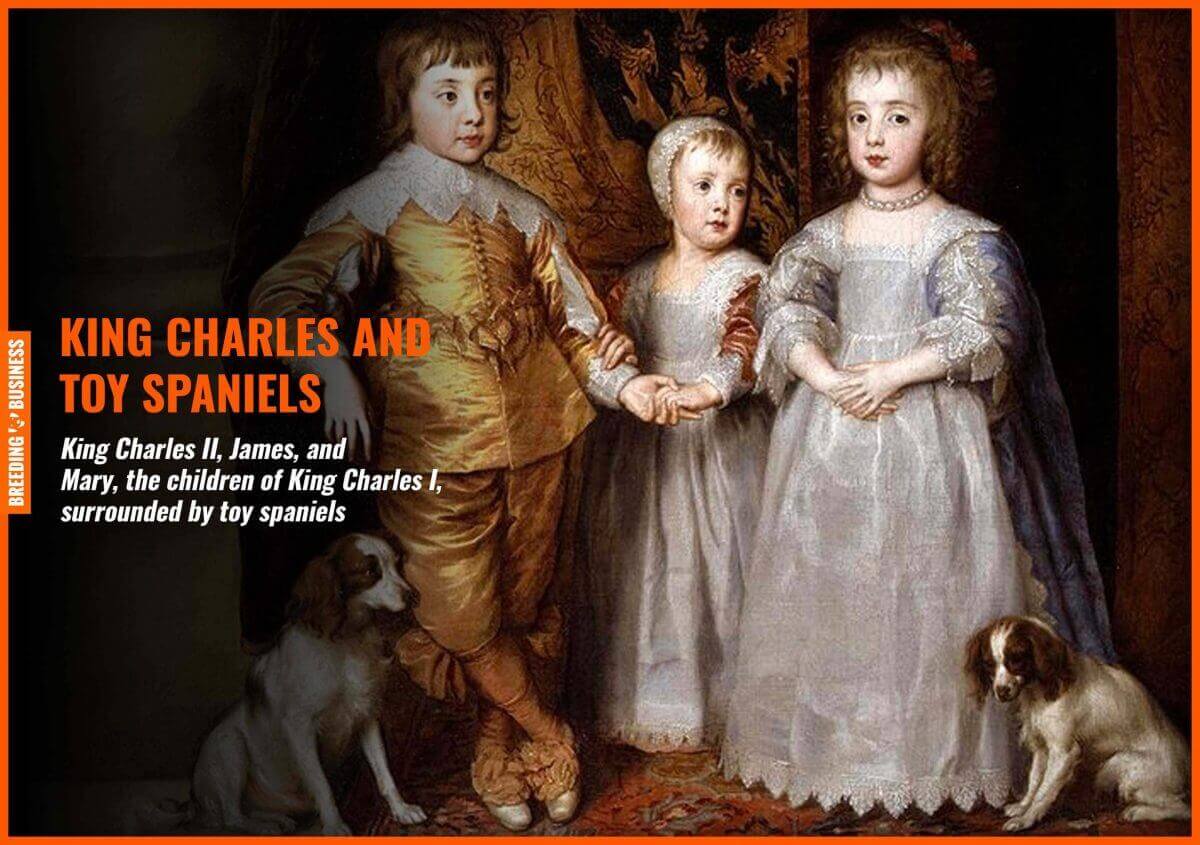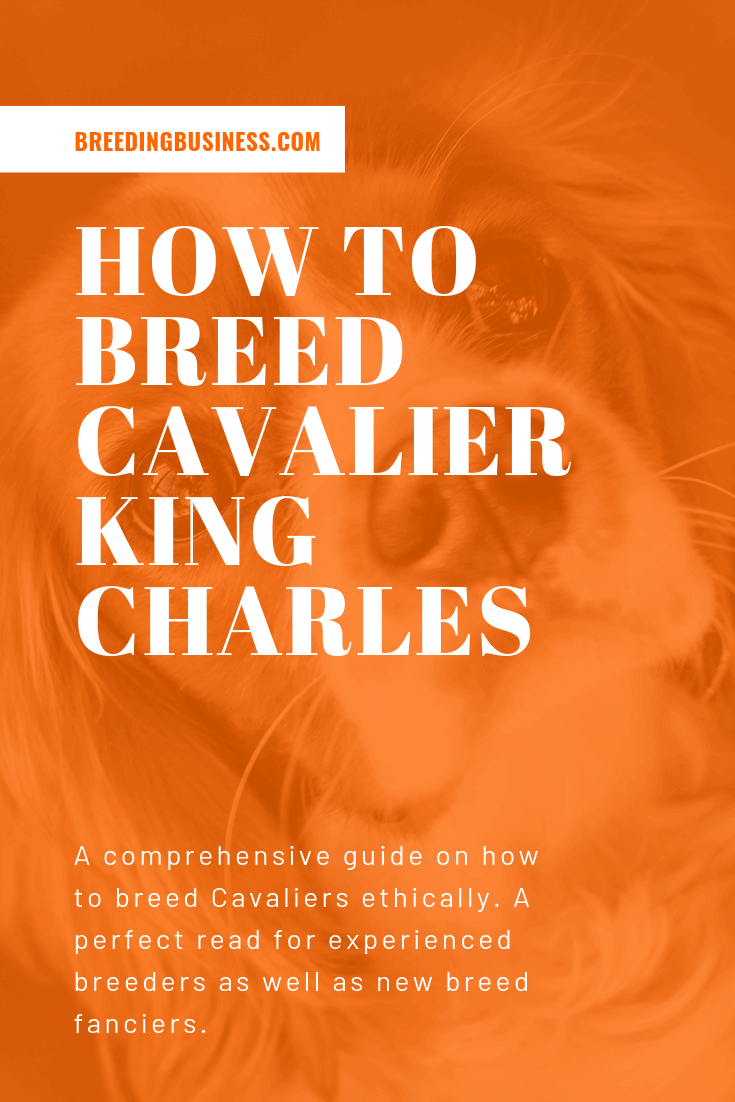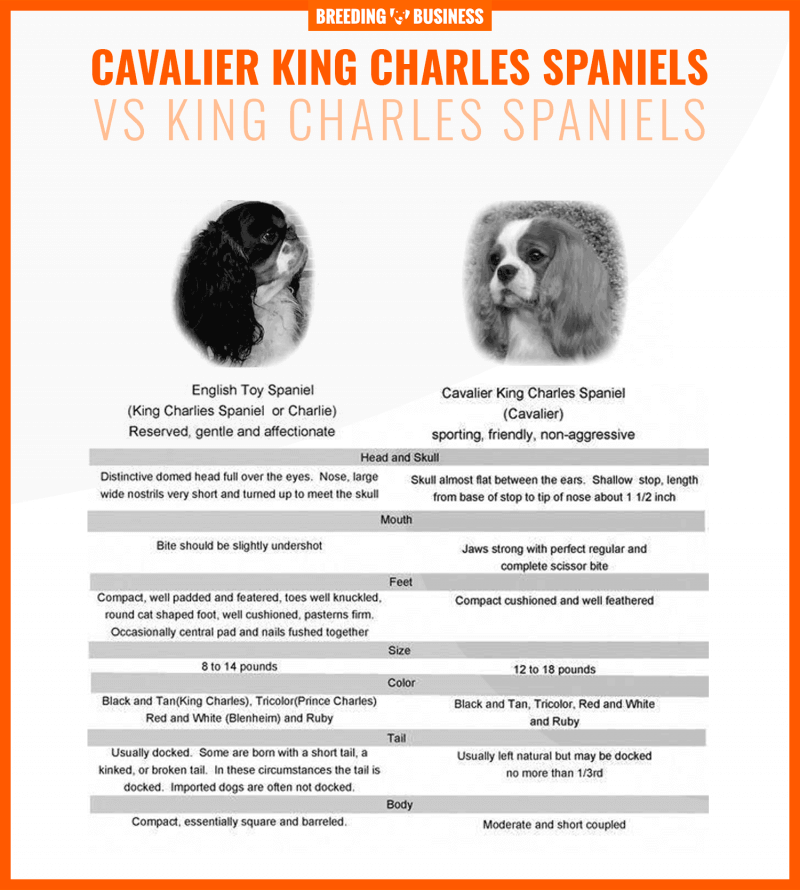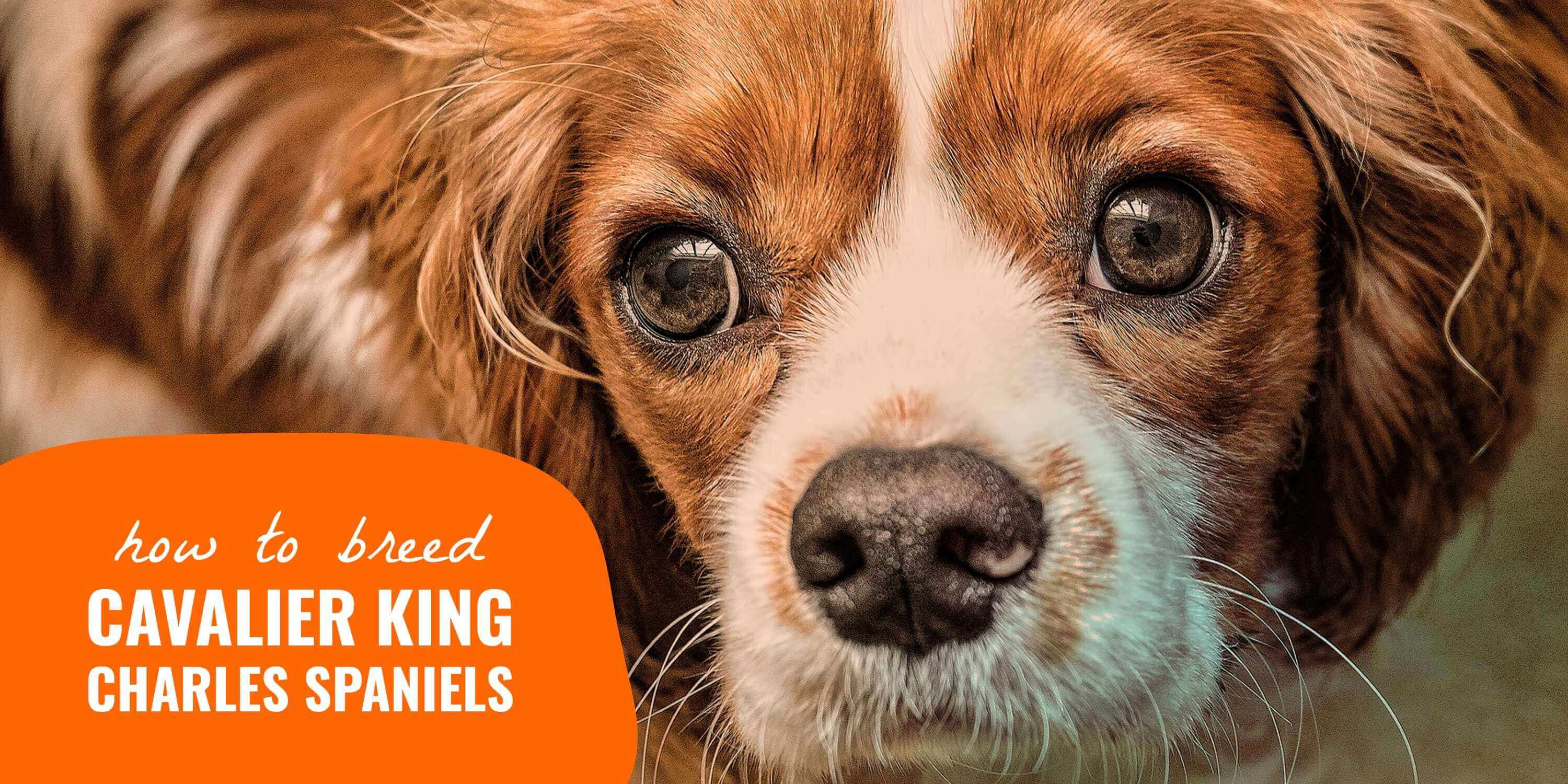Are you wondering how to breed Cavalier King Charles spaniels? Then look no further than this full guide that will show you everything you must know.
We’ll start with a fascinating trip to explore the history of this breed; their origins and how they became famous. You’ll also learn all about their temperament, personality, appearance, health issues and breeding best practices, supported by a FAQ section to answer all of your most common doubts.
Background of Cavalier King Charles Spaniels Breeding
Originally from the United Kingdom, the CKCS has managed to become the #19 most popular pure-breed dog in the US. To understand how it happened and what makes this breed special, here you have a proper background.
Spaniels in the Royal Courts
Toy Spaniels are the ancestors of Cavalier King Charles Spaniels of today and they were popular with European Royalty since Tudor times, especially in Spain (hence the name Spaniels), England, France, and Scotland.
This breed received the Royal title of King Charles Spaniels under the reign of the Stuarts, thanks to King Charles II, who loved these pups and was usually seen with two or three accompanying him. They enjoyed exclusive privileges such as unrestricted access to any public building.
They remained very popular even after Charles II, because toy spaniels became the dog of choice during the reign of King James II until that of Queen Anne.
Moving forward to 1800s, Queen Victoria shared the same love for this breed. Sir Edwin Landseer, this being his first royal commission, painted her dog, Dash, which we can appreciate below.
The Duke and Duchess of Marlborough shared the same passion for this breed, and the Duke, John Churchill, is recognized as the first in Britain to breed toy spaniels with the classical white and red coloring. Therefore, they received the name of Blenheim Spaniels.
Undoubtedly, Toy Spaniels formed an important part in Royal families, especially in England, thanks to their loving and friendly nature, and according to John Caius, due to being kind, neate and delicate.
As you’ve seen, they form part of the work of notorious artists, and therefore, they are one of the most important breeds in England.
Beginnings of Toy Spaniels
According to evidence and research, they originated in Southeast Asia and appeared for the first time in Europe during the 16th century. More precisely, they are thought to have come from Japan, and therefore, they share certain traits in common with the Japanese Chin and Pekingese.
Nonetheless, there is evidence that the Knight, Sir William Fitzralph, brought with him some small spaniels from Italy, after returning from the Crusades in the 13th century. `There are brass effigies found in his parish Church in Pebmarsh, Essex, which show a small spaniel curling at the feet of the Knight.
It’s a centuries-old breed that gave origin to this incredible breed as we know it today.

Cavalier King Charles Spaniels, Today
They have grown immensely in popularity and it only keeps raising. Nowadays, it’s the 19th most popular dog breed in the United States of America. From Frank Sinatra to Ronald Reagan, several celebrities have adopted a Cavalier at some point. Thanks to this vast popularity, many want to know how to breed Cavalier King Charles ethically. Indeed, because it’s a profitable business in demand as long as it is done responsibly.
Furthermore, the following countries have clubs dedicated to the breed:
- USA
- UK
- Canada
- Spain
- Sweden
- South Africa
- Belgium
- Czech Republic
- Finland
- Denmark
- Germany
- Netherlands
- Norway
- Australia
- New Zealand
The popularity and presence of this breed are global. It’s mainly due to its loving, affectionate and easygoing nature. They love their owners and are always eager to please, and therefore, the Cavalier King Charles Spaniel’s behavior is a powerful hook that gets people to prefer this breed.
Appearance
Its unique appearance is one of the main factors that contributed to the rise of this breed, making it one of the most popular toy dogs in the world. Here you have all the details about it.
Size and Weight
It’s amongst the largest toy breeds, ranging from 12 to 13 inches in height and a weight of 13 to 18 pounds. Even then, its diminutive size makes it the ideal lap dog.
Colors
There are four recognized colors:
- Blenheim: Chestnut and white markings
- Tricolor: A mix of black and white marketing, with a remarkable white splash between the eyes
- Black and Tan: Black body and tan highlights
- Ruby: Totally chestnut or liver colored
Face
Its face is, by far, the most distinctive feature of the Cavalier King Charles Spaniel. It’s flat and possesses a sweet and gentle expression, which accompanied by its big and round brown eyes, make it a truly beautiful breed.
It is, to date, unclear whether Cavalier King Charles are brachycephalic dogs or not.
Body
[adwithin]
Squarish and compact. The body of the Cavalier King Charles spaniel is longer than tall. They should never seem long and low, because it is a clear evidence of faults in the breed, and if you notice short legs and long backs, then you can absolutely confirm it.
Its elongated and elegant neck, which sets atop its sloping shoulders; along with its slightly-deep chest, make a beautiful contrast with its squarish body. In addition, its tail is the cherry top, because when in motion, it makes the dog look sophisticated and sweet. The perfect combo.
Ears
Long and wavy ears. Without them, the face would lack frame, and in consequence, the Cavalier King Charles Spaniel would lose its charm. Nonetheless, they serve a purpose beyond aesthetics, because they serve to protect the inner and middle ear mechanisms. Silky, beautiful and useful.
Coat
Wavy, medium in length and straight. It’s soft and silky to the touch and hits the sweet spot of density. Therefore, it’s one of the most remarkable and desired aspects of the breed.
Nonetheless, these dogs have lots of hair, and hence, daily grooming is a must to keep it beautiful and healthy.
Personality and Temperament
The King Charles Cavalier personality is usually friendly, happy and easygoing. Nonetheless, such a bright personality has its pros and cons. We’ll discuss them below.

Easy to Train
Thanks to their friendly nature, they are fast to trust people, and hence, it makes training much easier and more efficient. Furthermore, they are very smart. You can train them to behave exactly as you expect them to in record time. They can do all sort of tricks, and they are especially emotionally intelligent.
Cavaliers can learn a trick in 25-40 repetitions and obey 50% of the time, similar to breeds like the Irish wolfhound, Finnish Spitz, and Siberian Husky.
They are the perfect companion because they love to be around people. Therefore, they are excellent for people who spend a lot of time at home, like retirees and seniors. The ideal comforter dog.
Cuddly
Lovebug. It defines the temperament and personality of the Cavalier in a nutshell. They will lick your face whenever they get the chance! They are very affectionate, and therefore, they are great for people who suffer from depression. One of the best dog breeds for mental health support.
They are amazing therapy dogs. It’s probably one of the best traits of this breed, because thanks to their nature, they reduce anxiety, stress, and depression. As they are always eager to play, you will receive an increase of dopamine and oxytocin, and therefore, you will improve your mood and general health.
Drive of a Hunter
Due to their friendly nature, they are not good watch or alarm dogs. They will bark when they sense someone near to your home; however, it will be only to greet them.
They are also very active, and due to being a hunter breed, they will chase anything. From bikes to cars and small animals and other dogs, they will “hunt” just about everything. Therefore, you always need to keep an eye on them, because it can end in a disaster.
Separation Anxiety
Also, you need to know that they hate being alone. They love being around people, and therefore, they can develop anxiety issues if they are isolated constantly (i.e. separation anxiety). Furthermore, they can develop destructive behaviors. One of the biggest drawbacks of the Charles King Cavalier personality.
Finally, as mentioned earlier, they love to lick. Many will appreciate it, while some will be bothered by it. Up to you!
With Children
They are excellent for homes with children, because they love to play. They are very active, and hence, they can keep up with the case of most small children. They will bring joy and happiness to your home.
However, they may not be the best for homes with toddlers, because they can charge on your Cavalier or play with them with too much force, which can result in injuries.
Health Issues when Breeding Cavalier King Charles
Even though it is a generally healthy breed, you still need to be aware of certain health complications. You’ll find a detailed description for each.
Lifespan of a Cavalier King Charles Dog
Cavalier King Charles Spaniels live between 9 to 14 years old. With proper nutrition and care, your Cavalier will spend many years along your side. Therefore, it’s important to bring them an optimal diet and an active life style. They are hunter dogs, after all. They need lots of activity.
Common Health Problems
To ensure a long and healthy life for your Cavalier, it’s important to be aware of the most common health problems, to monitor them and get help from your veterinarian as soon as possible when you detect them. Prevention is key when breeding cavalier King Charles.
Hip Dysplasia (HD)
A recurrent genetic disease develops with age. It causes abnormal development of the hip, which leads to severe pain and arthritis in its different degrees from 1 to 4.
Furthermore, according to the OFA database, it affects 15.5% of Cavalier King Charles spaniels. Nonetheless, such percentage can be higher, because even in adult CKCSs with severe hip dysplasia, it’s hard to diagnose them with common methods like x-rays. Use a trusted OFA screening to grade the severity of your Cavalier’s dysplasia.
Mitral Valve Disease (MVD)
[adwithin]
It’s the top-ranked cause of death for Cavaliers because according to The Kennel Club, 42.8% of deaths were due to cardiac health problems. MVD worsens progressively, and hence, it can evolve into congestive heart failure, and consequently, provoke death.
It affects practically all Cavaliers, and by age 10, most of them already have the characteristic heart murmur of MVD. In consequence, it is important for you as an owner to be aware of it, so you can treat it to guarantee a healthy and happy life to your dog.
It’s a very serious issue, and therefore, there is a breeding protocol that addresses MVD. The following associations have endorsed it:
- UK’s Cavalier King Charles Spaniel Club
- Cavalier King Charles Spaniel Club of Canada
- Dutch Kennel Club
- Swedish Kennel Club
- Cavalier King Charles Spaniel Club, USA
Unfortunately, especially in the USA, only a handful of breeders have followed the guidelines brought by veterinary specialists. That is despite MVD has proven to be highly inheritable. Indeed, selection against it should be successful to reduce the percentage of new generations of CKCSs that suffer from it.
Syringomyelia (SM)
Also known as Occipital hypoplasia (OH) and neck scratcher’s disease. A common health problem that affects 70% of Cavalier King Charles spaniels by age six. It is distinguished by cavities filled with fluid in the spinal cord of the neck (parenchyma), as a direct result of abnormal pressure around it.
Although the causes of the disease remain unclear, the evidence suggests that it is a result of the obstruction of cerebrospinal fluid at the foramen magnum level.
Furthermore, such obstruction is usually caused by a malformation of the caudal fossa, which is a very common ailment in this breed, because it affects nearly 95% of them. Evidence also shows us that 50% of CKCSs with a caudal fossa malformation also suffer from Syringomyelia, thus, showing a strong correlation between the two ailments.
Keratoconjunctivitis Sicca
It also receives the name of dry eye. This disease affects the normal production of tears, which leads to damage to the surface of the eyes, and therefore, it results in pain and making the area more susceptible to infections. In addition, it is often accompanied by dry flaky skin.
It’s a disease that mostly affects Cavalier King Charles Spaniels, and unfortunately, it is hard to treat. It shows signs since the dog is a puppy, and in most cases, owners opt for euthanasia. Indeed, it leads to severe infections, corneal ulcers, and intense pain, and the treatment does not do much to alleviate it.
Patellar Luxation
It is also known as loose knees. Like hip dysplasia, it’s a hereditary health problem and it provokes luxating patellas, which displaces the kneecap from the groove. In fact, Cavalier King Charles Spaniels are amongst the most affected breeds, like Chihuahuas, toy poodles and Boston terriers.
Early diagnosis is essential because it deteriorates progressively and will affect the mobility of your pet. Furthermore, it will cause intense pain and limit the normal life of your dog.
Episodic Falling
The Episodic Falling Syndrome exclusively affects this breed. It is caused by a mutation of the BCAN gene, which is related to brain function. The symptoms tend to show when the dog is stressed or exercised. The muscles get tense and unable to relax, causing the animal to fall and remain in such a state.
Fortunately, it does not get worse with the passing of time. However, therapy has proven to be effective to alleviate its effects.
How To Breed Cavalier King Charles

You can avoid all of these problems by breeding with dogs that have an impeccable health history. In fact, that is why guidelines and protocols exist, to combat these diseases.
Average Litter Size
The typical litter of a Cavalier King Charles Spaniel is five puppies. For first-time mommies, the average litter size is smaller, usually two or three puppies. The littler size tends to increase the more time a Cavalier gives birth, but it usually caps at six puppies and often decreases after the fourth litter.
Studs
It is also critical to choose a high-quality stud. Make sure to follow these precautions when breeding Cavalier King Charles Spaniels through a stud service:
- The stud should be free of the most common health problems that affect the breed, ex: MVD and Keratoconjunctivitis Sicca
- It should display the loving and kind behavior that characterizes the breed
- It must have been DNA tested for the Episodic Falling Syndrome
Birthing Problems
Most of the time, CKCS do not present problems when giving birth to a littler. However, it’s worth noting that hip dysplasia may cause certain issues. Furthermore, it is important to watch the weight of your dog, because getting fat can cause problems when giving birth because it will make the delivery of the puppies more challenging.
[adwithin]
Therefore, if your dog suffers from hip dysplasia and it is overweight, you need to check in with your vet regularly during the pregnancy.
Price
The price for a Cavalier King Charles puppy ranges between $1,500 and $3,500. However, such estimation will vary depending on certain factors:
- Bloodline – the healthier and more reputable, the more expensive
- Color – Blenheim, and Ruby are in high demand, and therefore, they are pricier
- Documentation – the more documented a puppy is, the more it will go for
To bring you an even more realistic estimation, let’s explore some specific cases:
- A Blenheim puppy from a Champion bloodline, which parents are registered at the AKC and Cavalier King Charles Spaniel Club USA, and that has been tested for all the most common health problems, can be yours for $3,500 USD.
- A black and tan puppy from a Champion bloodline and that includes an AKC certification, which parents are properly registered, and that is free from all the major diseases that affect the breed, can be yours for $2,500 USD.

Cavalier King Charles Spaniels – FAQ
This section will answer all of the most common doubts and questions that surround this dog breed.
Cavalier King Charles Spaniels don’t bark a lot due to their kind and easygoing nature. They can bark due to something that interests them or when they meet someone new. In addition, it is worth noting that some events can trigger them, for example, hearing other dogs barking, but it is completely natural. Furthermore, separation anxiety is another big trigger.
Other than that, they don’t bark more than other dogs. Therefore, they are not good alarm dogs. They are best at being comforter dogs.
They are different in size, skull shape, length of the muzzles, eyes, neck, and body.
The Cavalier King Charles Spaniel is larger and heavier. Its skull is flat between the ears, whereas the King Charles spaniel has a well-doomed skull which is noticeably large in proportion to its body. The Cavalier has longer muzzles, whereas the King Charles has short and squarish muzzles. The Cavalier has big and round eyes, while King Charles’s are noticeably large and are set wide apart. The neck of the Cavalier is more elongated and sophisticated.
Finally, the body of the Cavalier is compact and equipped with a firm spring of rib, while the King Charles’ is shorter and back level.
They shed a lot of hair all year around. You can reduce it by grooming its coat daily, along with regular baths. Furthermore, a healthy diet will contribute to making its coast beautiful and reducing the amount of hair they shed. In addition, using the right dog shampoo will make a noticeable difference.
If you decide to adopt a Cavalier King Charles, you will have to invest time into grooming and brushing its hair daily. It’s a strong bonding time for you and your dog, and in addition, it will make its coat soft and beautiful.
Cavalier King Charles Spaniels are not hypoallergenic. They can trigger allergies because they shed lots of hair, and in addition, because their coats are dense and large, they can pick up dirt, bacteria and allergens.
However, mixing it with other breeds has proven to alleviate this problem. The two best alternatives are the Cavapoo, which is a mix between a poodle and a Cavalier, and the Cavachon, a mix between a Bichon Frise and a Cavalier.
Now you know how to breed Cavalier King Charles Spaniels. They’re a good choice to breed because they bring a high return on investment, they are in high demand and you can avoid most of the common health problems by breeding with dogs from healthy bloodlines.

3 comments on “How To Breed Cavalier King Charles Spaniels”
very impressive information. now I have a question..my wife and i own 4 Cavis…two male and two female…here is the problem.our two cavalier males, one was born in 2016 and one in 2019, from the same dam. the first dog has bred with one cav female, and from the litter, there are two females. can these females be bred with the second male with no issues?
i dont know where else to ask…
thanks..
Ask a vet! Have them refer you to a reproductive specialist who can assess the lines. Sometimes “inbreeding” or “line-breeding” is acceptable if your dogs have good genetics, and if they are calculatedly genetically diverse enough…
Is it common for cavalier males to not breed naturally?
I’m doesn’t see to know how to do his business. Does anyone else have this problem with their male?
Or what can I do to fix it?